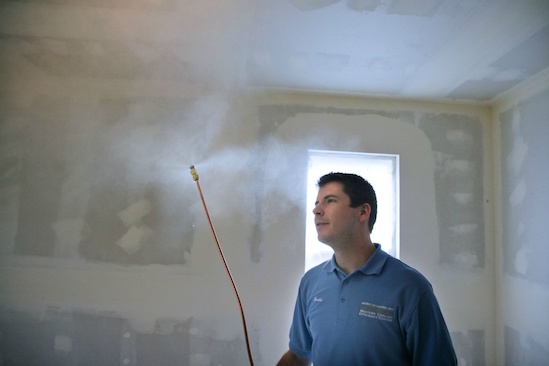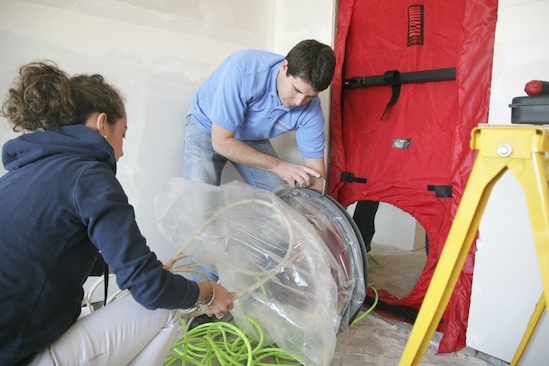Making houses airtight is one of the most cost-effective ways of making them more energy-efficient. Passive House builders obsess about their blower door tests, which test the entire house at once to see if it’s sealed well enough to meet the PH standard. Sealing is harder than it sounds, and many a failed blower door test has sent a crew back to spend another day or two with tape and caulk guns before retesting.
A new technology may soon provide a short cut—a way to seal an entire house in the space of an hour, producing blower door test scores today’s builders can only dream of.

The technology was invented at UC Davis sixteen years ago as a way to seal all of the ductwork in an existing house. A startup company, Aeroseal, picked it up and has been duct-sealing houses since 2001, winning “best-new-tech” accolades from the DOE and from “This Old House.”
Recently, the original inventor, Mark Modera, director of the Western Cooling Efficiency Center at UC Davis, started wondering if the method could be expanded to treat an entire house “envelope.” Last month the WCEC announced success after trying it on three Habitat for Humanity houses under construction in Stockton, California.

In these “already-sealed” houses it reduced leakage by about 50%. (WCEC has already developed monitors and software that graph the whole-house leakage rate in real time, while they are sealing it.) Before commercializing the technology they plan to refine it a little more, hoping to reach leakage rates too small to measure. Remember that the sealant has been effectively sealing ducts for twelve years already.
Here’s how it works. Once a house has been sealed (more or less) by conventional methods, they set it up for a blower door test: they tape a powerful fan into place in one door, and tape any additional doors and vents shut. They also install hoses running to mist-spray nozzles several feet above the floor in the center of each room. They blow air into the house until it is well pressurized, then spray their sealant liquid out in a fine mist through each nozzle. Air pressure sucks the sealant toward any and all points where air is leaking out of the house. The moment this special sealant reaches a tight space, it coagulates and seals. Apparently only minimal residue builds up on the inside surfaces.
Workers stay outside the house during spraying to avoid breathing the volatile propellants. Once solidified, though, the sealant is considered non-toxic and even “low-VOC.” (Indoor air quality is a serious concern in any airtight house, so they all have heat recovery ventilation systems to move air in and out while capturing its desired indoor temperature.)
The technology holds promise for existing housing as well as new construction. “We tried it in an existing home,” Modera told the Stockton Recorder. “I don’t feel comfortable thinking about doing it when there’s all the furniture in the house, but when someone moves out and you have an empty house, I think it will help.”